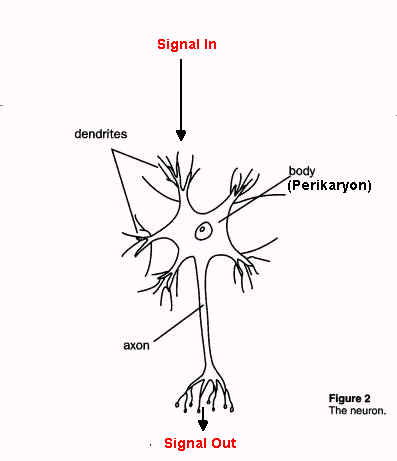
Neurotoxicology
Not a bad presentation in your book, but again, lots of details that you don't need to memorize. We talked about several of the items such as neurotransmitters earlier, so those parts should be a nice review. Here's a brief overview:
A "nerve" is a general term for the electrical wiring from one point in the body to another. Nerves are bundles impulse transmitting cells called neurons and insulating cells called glia, as well as some support tissue. There are several types of neurons in the central nervous system (CNS) and the peripheral nervous system (PNS), but most are similar functionally.
 |
A signal is transmitted as follows: a neurotransmitter affects a receptor on the dendrite, this kicks off an electrical signal that travels down the dendrite to the perikaryon (the cell body of the neuron). The signal travels across the body of the perikaryon toward the axon. If the signal is strong enough, it continues down the axon. At the far end of the axon, it releases neurotransmitters. If the termination is at a dendrite of another neuron, the signal continues. If the termination connects to a muscle, it causes it to contract. |
If the signal is not strong enough to cross the perikaryon, nothing happens. Because a neuron may have thousands of dendrites, dozens of signals can reach the perikaryon. These signals may sum and make the signal stronger, thus causing a signal to travel down the axon. The ends of the axon, in turn, especially in the CNS, may attach to hundreds of dendrites. The electrical signals travel by depolarization. Sodium ions, Na+, on the outside of the neuron cause the inside of the cell to be negative with respect to the outside. A signal causes an inward rush of sodium, which changes the polarity. It turns out that the signal that causes the depolarization is the depolarization of a nearby locus. After depolarization, the cell must pump the sodium out of the cell to repolarize it. Neurons must be electrically isolated from nearby neurons and this is accomplished with glial cells that wrap around the axon, or around the whole cell. In the motor neurons that run the skeletal muscles, the cell body is near the spine and the axon might be 3 or 4 feet long. Signals travel relatively quickly, because the axon is insulated, but has gaps in the insulation. The signal, depolarization, bounces from gap to gap.
Consider the neuron that moves your big toe. The cell body is located near your spine, and the axon, which is just a branch of the cell, is 2 or 3 feet long. The volume of the axon is hundreds of times the volume of the cell body. Now the nucleus, ribosomes, and all the protein building machinery are located in the cell body. So all the maintenance material for the axon, as well as some nutrients, must travel down the axon via a transport system.
With that brief introduction, you can see that anything that messes with the sodium and other ion channels will upset the polarization or re-polarization mechanism and shut off conduction via the neuron. Your dental anesthetic, Novocain or Lidocaine (and most local anesthetics), acts by blocking the sodium channels.
Toxicity to the neurons is sometimes placed into one of four categories.
You might want to stop here to read the chapter, or you may proceed.
Here are two agents that cause neuronopathies:
Methylmercury
Earlier we read about the extreme toxicity of dimethyl mercury. Methylmercury has only one methyl group bound to the mercury. Alternatively, if elemental mercury finds it way into the environment, it may be oxidized to Mercurous ion Hg++ or converted by bacterial into Methylmercury. The same conversion can take place in the GI tract. Here the Minamata story, told by Wikipedia I'll ask a homework question that relates to Minamata.
MPTP
Several years ago, there was a rash of hospital admissions of young people who had Parkinson's Disease. While not unknown in youth, it would be very rare. Parkinson's disease is caused by death of neurons in a region of the brain called the substantia nigra where the neurons use the chemical dopamine as the neurotransmitter. (These are called dopaminergic neurons.) A little more from Wiki
Axonopathy
Peripheral Neuropathy (not "neuronopathy" discussed above) refers to the clinical effects of axonal loss. Typically muscle weakness, loss of reflexes, and glove and stocking sensory loss. About half way down the page, this site has a photo of "wrist drop" a clinical sign of sever peripheral neuropathy. Click for large photo. neuropathy.http://www.ncbi.nlm.nih.gov/pmc/articles/PMC2812735/l
Here is a quick list of neurotoxic agents. Some are drugs, most are chemicals http://neuromuscular.wustl.edu/nother/toxic.htm